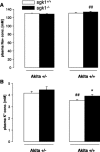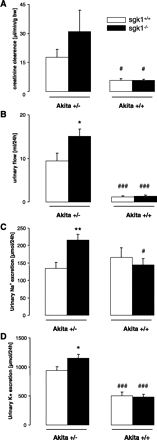SGK1-sensitive renal tubular glucose reabsorption in diabetes
- PMID: 19158347
- PMCID: PMC3973646
- DOI: 10.1152/ajprenal.90238.2008
SGK1-sensitive renal tubular glucose reabsorption in diabetes
Abstract
The hyperglycemia of diabetes mellitus increases the filtered glucose load beyond the maximal tubular transport rate and thus leads to glucosuria. Sustained hyperglycemia, however, may gradually increase the maximal renal tubular transport rate and thereby blunt the increase of urinary glucose excretion. The mechanisms accounting for the increase of renal tubular glucose transport have remained ill-defined. A candidate is the serum- and glucocorticoid-inducible kinase SGK1. The kinase has been shown to stimulate Na(+)-coupled glucose transport in vitro and mediate the stimulation of electrogenic intestinal glucose transport by glucocorticoids in vivo. SGK1 expression is confined to glomerula and distal nephron in intact kidneys but may extend to the proximal tubule in diabetic nephropathy. To explore whether SGK1 modifies glucose transport in diabetic kidneys, Akita mice (akita(+/-)), which develop spontaneous diabetes, have been crossbred with gene-targeted mice lacking SGK1 on one allele (sgk1(+/-)) to eventually generate either akita(+/-)/sgk1(-/-) or akita(+/-)/sgk1(+/+) mice. Both akita(+/-)/sgk1(-/-) and akita(+/-)/sgk1(+/+) mice developed profound hyperglycemia (>20 mM) within approximately 6 wk. Body weight and plasma glucose concentrations were not significantly different between these two genotypes. However, urinary excretion of glucose and urinary excretion of fluid, Na(+), and K(+), as well as plasma aldosterone concentrations, were significantly higher in akita(+/-)/sgk1(-/-) than in akita(+/-)/sgk1(+/+) mice. Studies in isolated perfused proximal tubules revealed that the electrogenic glucose transport was significantly lower in akita(+/-)/sgk1(-/-) than in akita(+/-)/sgk1(+/+) mice. The data provide the first evidence that SGK1 participates in the stimulation of renal tubular glucose transport in diabetic kidneys.
Figures








References
-
- Akutsu N, Lin R, Bastien Y, Bestawros A, Enepekides DJ, Black MJ, White JH. Regulation of gene expression by 1alpha,25-dihydroxyvitamin D3 and Its analog EB1089 under growth-inhibitory conditions in squamous carcinoma Cells. Mol Endocrinol 15: 1127–1139, 2001 - PubMed
-
- Alvarez de la Rosa D, Zhang P, Naray-Fejes-Toth A, Fejes-Toth G, Canessa CM. The serum and glucocorticoid kinase sgk increases the abundance of epithelial sodium channels in the plasma membrane of Xenopus oocytes. J Biol Chem 274: 37834–37839, 1999 - PubMed
-
- Alvarez de la Rosa D, Canessa CM. Role of SGK in hormonal regulation of epithelial sodium channel in A6 cells. Am J Physiol Cell Physiol 284: C404–C414, 2003 - PubMed
-
- Belaiba RS, Djordjevic T, Bonello S, Artunc F, Lang F, Hess J, Gorlach A. The serum- and glucocorticoid-inducible kinase Sgk-1 is involved in pulmonary vascular remodeling: role in redox-sensitive regulation of tissue factor by thrombin. Circ Res 98: 828–836, 2006 - PubMed
-
- Bhargava A, Fullerton MJ, Myles K, Purdy TM, Funder JW, Pearce D, Cole TJ. The serum- and glucocorticoid-induced kinase is a physiological mediator of aldosterone action. Endocrinology 142: 1587–1594, 2001 - PubMed
Publication types
MeSH terms
Substances
Grants and funding
LinkOut - more resources
Full Text Sources
Medical

